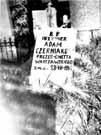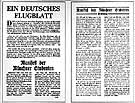
|
|
|

|

|

|

|
|
Click on an image to see a larger, more detailed picture.
|
|
|
|
|
| 1942: The "Final Solution" |

|
pg. 350 |

|
|
|
|
| |

|
 Head of the Judenrat (Jewish Council) in Warsaw, Adam Czerniaków was caught between the dictates of his conscience and the demands imposed upon him by the Nazis. In late July 1942 new deportations were ordered with the goal of greatly reducing the ghetto. When Czerniaków learned that even the children and orphans would not be spared, he decided to take his own life, writing in his diary: "My heart trembles in sorrow and compassion. I can no longer bear all this."
Head of the Judenrat (Jewish Council) in Warsaw, Adam Czerniaków was caught between the dictates of his conscience and the demands imposed upon him by the Nazis. In late July 1942 new deportations were ordered with the goal of greatly reducing the ghetto. When Czerniaków learned that even the children and orphans would not be spared, he decided to take his own life, writing in his diary: "My heart trembles in sorrow and compassion. I can no longer bear all this."
Photo: Ghetto Fighters' House / United States Holocaust Memorial Museum Photo Archive
|
 Calling for "freedom and honor," this flyer from the White Rose organization urges German youth to rise up against Nazi tyranny. Devastated by the deaths of so many young men at the battle of Stalingrad, siblings Sophie and Hans Scholl and their circle of courageous friends struggled to change Germany's course. Using carefully hidden duplicating machines and varying the sources for paper and ink, they printed leaflets that were distributed at the University of Munich and at other universities throughout Germany.
Calling for "freedom and honor," this flyer from the White Rose organization urges German youth to rise up against Nazi tyranny. Devastated by the deaths of so many young men at the battle of Stalingrad, siblings Sophie and Hans Scholl and their circle of courageous friends struggled to change Germany's course. Using carefully hidden duplicating machines and varying the sources for paper and ink, they printed leaflets that were distributed at the University of Munich and at other universities throughout Germany.
Photo: Bilderdienst SYddeutscher Verlag
|
 Swedish Prince Gustavus Adolphus visits Germany in 1942. Swedish policy was mildly pro-German until February 1943, when the German advance in Russia was stopped at Stalingrad--a crucial turning point in World War II. At that point, the Swedes and most Europeans felt that the Allies would win the war. As a result, Sweden decided to accept Jewish refugees. In October 1943 the country opened its doors to roughly 10,000 Danish Jews.
Swedish Prince Gustavus Adolphus visits Germany in 1942. Swedish policy was mildly pro-German until February 1943, when the German advance in Russia was stopped at Stalingrad--a crucial turning point in World War II. At that point, the Swedes and most Europeans felt that the Allies would win the war. As a result, Sweden decided to accept Jewish refugees. In October 1943 the country opened its doors to roughly 10,000 Danish Jews.
Photo: Suddeutscher Verlag Bilderdienst
|
|

|

|

|

|
 August 13-27, 1942: 53,750 Jews from Warsaw are deported to the Treblinka death camp.
August 13-27, 1942: 53,750 Jews from Warsaw are deported to the Treblinka death camp.
|
 August 13-27, 1942: United States State Department officials and the British Foreign Office decide that the Riegner Cable outlining details of the Holocaust be kept secret.
August 13-27, 1942: United States State Department officials and the British Foreign Office decide that the Riegner Cable outlining details of the Holocaust be kept secret.
|
 August 14, 1942: The entire Jewish community from Gorlice, Poland, is deported to the Belzec extermination camp.
August 14, 1942: The entire Jewish community from Gorlice, Poland, is deported to the Belzec extermination camp.
|
 August 14-15, 1942: A woman named Rivka Yosselevska is one of just four Jews to survive a bloody burial-pit massacre outside Zagrodski, Poland, near Pinsk.
August 14-15, 1942: A woman named Rivka Yosselevska is one of just four Jews to survive a bloody burial-pit massacre outside Zagrodski, Poland, near Pinsk.
|
|
|
|
|
| 1942: The "Final Solution" |

|
pg. 350 |

|
|
The Holocaust Chronicle
© 2009 Publications International, Ltd.
|
|
